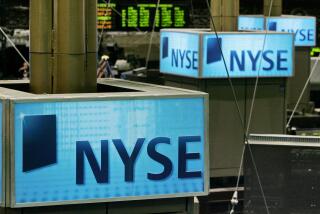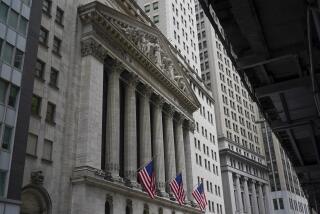Outlook grows dimmer for stock-picking fund managers

Today’s infants may gasp in wonder 20 years from now at tales of how humans once were trusted to drive cars. They may also be shocked that humans once were trusted to pick stocks for investment portfolios.
The soaring popularity of “index” or “passive” mutual funds in the last few years has dealt another blow to the ranks of traditional “actively managed” funds — the ones with human portfolio managers who are supposed to ferret out the best stocks and beat the market average return.
Despite the roaring bull market since 2009, the number of actively managed U.S. stock funds has shrunk from 3,466 in 2006 to 2,957 now, according to the Investment Company Institute, mutual funds’ trade group.
Charles Ellis, one of the best-known chroniclers of the investment management business, believes that this is the beginning of the end for active management. His 2016 book, “The Index Revolution: Why Investors Should Join It Now,” pulled no punches.
The long-term performance numbers are sobering enough. In the 15 years through 2016, the vast majority of actively managed funds that own a diversified portfolio of U.S. big-company stocks trailed the indexes they were supposed to beat. Just 25.3% of those funds gained more than their index, according to Morningstar Inc.
The winning percentages were similarly low for funds that own shares of mid-size U.S. companies (20.5%) and for funds investing in emerging-markets stocks (36.4%), among others.
But Ellis says it’s worse than it looks, in part because the data don’t capture funds that performed so poorly they were liquidated before even 10 years had passed.
In an op-ed he wrote in the Financial Times in January, Ellis said the reality was stark: “Actively managed funds are not beating the market. The market is beating them.” The industry’s future, he said, “is grim.”
Why, then, do investors still keep $4.8 trillion in actively managed U.S. stock mutual funds, and many trillions more in actively managed stock, bond and hedge funds worldwide?
Inertia clearly plays a large role: It’s easier for investors to stay where they are than move their money. Also, selling an investment that isn’t in a tax-sheltered account can create what Wall Street likes to call a “tax event” (i.e., a taxable capital gain).
But active management survives for other reasons. For one, performance data don’t adjust for risk. If a fund manager earned slightly less than the fund’s index over a given period, but took much less risk of loss with the portfolio, investors may judge that shortfall to be well worth it.
When you consider the risk factor, “the conventional wisdom that active always underperforms passive is not true,” said Brian Reid, chief economist at the Investment Company Institute.
Marlene and Werner Roestel, retirees who live in Granada Hills, have built an investment nest egg made up of active and passive mutual funds, exchange-traded funds and individual stocks including Boeing Co. and healthcare firm Becton Dickinson & Co.
“We’re not really trying to beat the market,” Marlene Roestel said. Instead, she said, the couple wants to be very diversified, minimize their risk of loss and earn cash dividends. They also enjoy the challenge of investing.
“It’s kind of a hobby for us,” Roestel said. “When you’re retired you have more time for this.”
Basic human nature also keeps some investors actively engaged in the market rather than handing their money to passive funds.
“I like thinking I can beat them,” said lifelong Los Angeles resident Jeff Bruce, 74, who owns stocks including Apple Inc., Home Depot Inc. and American Water Works Co.
“I try to be buy-and-hold,” Bruce said. But his attitude is “they’re not necessarily mistakes just because they lose.”
Even Vanguard Group, the premier index mutual fund manager, contends that there’s a place for active funds in investors’ portfolios. In fact, of Vanguard’s $4 trillion in fund assets, about one-third are in actively managed funds.
“We’re strong believers in active,” said Joseph Brennan, Vanguard’s global head of equity indexing. “What we believe is you should be implementing them both, active and passive, with low-cost funds.”
One of the active-management industry’s most famed funds is the $52-billion-asset Vanguard Primecap fund, based in Pasadena. The portfolio, which primarily invests in well-known stocks including Microsoft Corp., Southwest Airlines Co. and Wells Fargo & Co., has trounced the Standard & Poor’s 500 index over the last 15 years, gaining 9.7% a year to the S&P index’s 7.2%.
Part of that success is owed to Primecap’s low management fee. A fund’s management fee is taken directly from the portfolio each year to pay the managers, thereby reducing investors’ return. Primecap’s fee is 0.39% of fund assets. By contrast, investors pay about twice that much at the average U.S. stock fund.
Matthew Raab, a 28-year-old accountant in Los Angeles, has accumulated some cash savings that he’s hoping to invest in the next year. He is aware of the arguments for low-cost passive funds, but said he’s open-minded to active funds despite their higher fees. “It’s not a deterrent for me if they’re earning their keep” with better performance, he said.
But Raab’s generation lacks high-profile stock pickers such as Peter Lynch, who scored spectacular gains managing Fidelity’s Magellan Fund in the 1980s. He achieved almost rock star status with baby boomers in that era, and persuaded many small investors that the market could be beaten.
Today, one easy way for actively managed funds to boost their investors’ returns would be to slash management fees. Relentless competition drove down the average U.S. active-fund fee incurred by investors from 1.01% in 2000 to 0.78% by 2015, according to a Morningstar study. But the average passive fund fee also has fallen, from 0.26% to a mere 0.18%.
The result is a 0.60-percentage-point fee gap between the two. On every $1 trillion in active-fund assets, that amounts to $6 billion in income to fund managers.
The industry says it is working to cut fees faster, particularly on fund shares in retirement savings accounts.
But Russ Kinnel, director of fund manager research at Morningstar in Chicago, said fund companies overall “are wary of starting a price war. They don’t want to call attention to themselves.”
Particularly in the case of fund companies that are publicly traded, and have their own shareholders to serve, “they don’t want to be cutting fees before they absolutely have to,” Kinnel said.
But if cash continues to pour out of active funds, that tipping point may be fast approaching.






